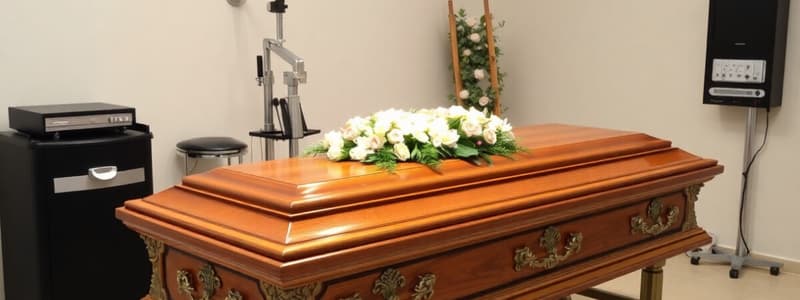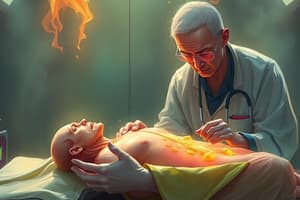Podcast
Questions and Answers
What is the primary legal definition of embalming?
What is the primary legal definition of embalming?
- The disinfection of microorganisms present in a body.
- The treatment of a corpse with preservatives to prevent decay. (correct)
- The restoration of the deceased's physical appearance.
- The preservation of the body for burial.
Which of the following is NOT a reason for embalming?
Which of the following is NOT a reason for embalming?
- Preservation against decomposition.
- Restoration of the body to natural appearance.
- Disinfection of pathogenic organisms.
- Religious practices and rituals. (correct)
What is one major consequence of neglecting the care of the dead in a culture?
What is one major consequence of neglecting the care of the dead in a culture?
- An increase in public trust.
- Enhanced funeral traditions.
- Improved community cohesion.
- The downfall of that culture or community. (correct)
Which of the following fields is NOT typically included in embalmer education?
Which of the following fields is NOT typically included in embalmer education?
What aspect of public trust is related to embalmers?
What aspect of public trust is related to embalmers?
Which statement reflects the beliefs of various cultures with regard to the dead?
Which statement reflects the beliefs of various cultures with regard to the dead?
What is the primary purpose of disinfection in embalming?
What is the primary purpose of disinfection in embalming?
Which of these is part of the preparation process in embalming?
Which of these is part of the preparation process in embalming?
What does the term 'saprophytic bacteria' refer to in the context of embalming?
What does the term 'saprophytic bacteria' refer to in the context of embalming?
What is required before transferring the deceased to ensure proper identification?
What is required before transferring the deceased to ensure proper identification?
Which of the following is NOT considered a mode of disinfection?
Which of the following is NOT considered a mode of disinfection?
Which of the following actions is required for the body before embalming?
Which of the following actions is required for the body before embalming?
What must be done with medical devices before embalming a body?
What must be done with medical devices before embalming a body?
What is required for authorization to perform tasks other than embalming?
What is required for authorization to perform tasks other than embalming?
Which personal protection equipment is NOT mentioned as necessary?
Which personal protection equipment is NOT mentioned as necessary?
During which phase of disinfection is it essential to perform concurrent disinfection?
During which phase of disinfection is it essential to perform concurrent disinfection?
What is the primary responsibility of an embalmer when they suspect a suspicious death?
What is the primary responsibility of an embalmer when they suspect a suspicious death?
What must be established to minimize or eliminate conditions harmful to health after the embalming process?
What must be established to minimize or eliminate conditions harmful to health after the embalming process?
Which of the following is NOT a manner of death recognized in the classifications?
Which of the following is NOT a manner of death recognized in the classifications?
What is the disposal requirement for waste generated from the embalming procedure?
What is the disposal requirement for waste generated from the embalming procedure?
Which regulation does NOT align with federal compliance standards in this context?
Which regulation does NOT align with federal compliance standards in this context?
What method of embalming involves direct injection into body tissues using a syringe needle?
What method of embalming involves direct injection into body tissues using a syringe needle?
What does disinfection in embalming primarily focus on?
What does disinfection in embalming primarily focus on?
What substance is primarily used in embalming to convert body tissues and prevent decomposition?
What substance is primarily used in embalming to convert body tissues and prevent decomposition?
Which classification of embalming is specifically used for medical school dissection?
Which classification of embalming is specifically used for medical school dissection?
How is the manner of death categorized when investigations are still ongoing?
How is the manner of death categorized when investigations are still ongoing?
Which of the following best describes the goal of preservation in embalming?
Which of the following best describes the goal of preservation in embalming?
What essential characteristic does surface embalming primarily involve?
What essential characteristic does surface embalming primarily involve?
What must an embalmer consider regarding privacy in their professional conduct?
What must an embalmer consider regarding privacy in their professional conduct?
What must an embalmer do regarding the identification of the deceased?
What must an embalmer do regarding the identification of the deceased?
Which of the following actions is prohibited regarding misrepresentation?
Which of the following actions is prohibited regarding misrepresentation?
What is one responsibility of the funeral director regarding health and sanitation?
What is one responsibility of the funeral director regarding health and sanitation?
What should an embalmer document during the embalming process?
What should an embalmer document during the embalming process?
What should an embalmer avoid when dealing with a colleague?
What should an embalmer avoid when dealing with a colleague?
Which organization is primarily responsible for regulating embalming in many states?
Which organization is primarily responsible for regulating embalming in many states?
Which of the following is NOT a factor when making judgments about body donation?
Which of the following is NOT a factor when making judgments about body donation?
What type of information is allowed to be shared about the deceased?
What type of information is allowed to be shared about the deceased?
What is the main goal of maintaining competence as an embalmer?
What is the main goal of maintaining competence as an embalmer?
What action should be taken if an embalmer becomes aware of a hazardous material in the work environment?
What action should be taken if an embalmer becomes aware of a hazardous material in the work environment?
Flashcards
Etymology
Etymology
The study of the origin of words and how their meanings have changed throughout history.
Embalming
Embalming
The process of treating a deceased body with preservatives to prevent decay.
Legal Definition of Embalming
Legal Definition of Embalming
To treat a corpse with preservatives to prevent decay.
American Board of Funeral Service Definition of Embalming
American Board of Funeral Service Definition of Embalming
Signup and view all the flashcards
Embalmer Education
Embalmer Education
Signup and view all the flashcards
Embalmer Occupational Hazards
Embalmer Occupational Hazards
Signup and view all the flashcards
Embalmer Ethical Standards
Embalmer Ethical Standards
Signup and view all the flashcards
Disinfection in Embalming
Disinfection in Embalming
Signup and view all the flashcards
Preservation in Embalming
Preservation in Embalming
Signup and view all the flashcards
Restoration in Embalming
Restoration in Embalming
Signup and view all the flashcards
Cause of Death
Cause of Death
Signup and view all the flashcards
Manner of Death
Manner of Death
Signup and view all the flashcards
Hypodermic Embalming
Hypodermic Embalming
Signup and view all the flashcards
Anatomical Embalming
Anatomical Embalming
Signup and view all the flashcards
Privacy in Embalming
Privacy in Embalming
Signup and view all the flashcards
Respect in Embalming
Respect in Embalming
Signup and view all the flashcards
Vascular Embalming
Vascular Embalming
Signup and view all the flashcards
Surface Embalming
Surface Embalming
Signup and view all the flashcards
What is Judicious Counsel?
What is Judicious Counsel?
Signup and view all the flashcards
What is the role of the embalmer when dealing with body donation, organ donation, and autopsies?
What is the role of the embalmer when dealing with body donation, organ donation, and autopsies?
Signup and view all the flashcards
What is the rule regarding misrepresentation in the funeral industry?
What is the rule regarding misrepresentation in the funeral industry?
Signup and view all the flashcards
What is the concept of confidentiality in funeral services?
What is the concept of confidentiality in funeral services?
Signup and view all the flashcards
What is the rule against defamation of others in the funeral industry?
What is the rule against defamation of others in the funeral industry?
Signup and view all the flashcards
What is the rule regarding family accommodation in funeral services?
What is the rule regarding family accommodation in funeral services?
Signup and view all the flashcards
What is the rule regarding identification in funeral services?
What is the rule regarding identification in funeral services?
Signup and view all the flashcards
What are the key responsibilities in maintaining health, sanitation, and protection in a funeral home?
What are the key responsibilities in maintaining health, sanitation, and protection in a funeral home?
Signup and view all the flashcards
What is the importance of proper care and documentation when dealing with the deceased?
What is the importance of proper care and documentation when dealing with the deceased?
Signup and view all the flashcards
What is the importance of establishing a clear chain of custody?
What is the importance of establishing a clear chain of custody?
Signup and view all the flashcards
What is embalming?
What is embalming?
Signup and view all the flashcards
What is an Embalming Report?
What is an Embalming Report?
Signup and view all the flashcards
What is Primary Disinfection?
What is Primary Disinfection?
Signup and view all the flashcards
What is Concurrent Disinfection?
What is Concurrent Disinfection?
Signup and view all the flashcards
What is Terminal Disinfection?
What is Terminal Disinfection?
Signup and view all the flashcards
What is Personal Protection?
What is Personal Protection?
Signup and view all the flashcards
What is Authorization to Embalm?
What is Authorization to Embalm?
Signup and view all the flashcards
What is Authorization to perform procedures other than embalming?
What is Authorization to perform procedures other than embalming?
Signup and view all the flashcards
What are Minimum Standards in Embalming?
What are Minimum Standards in Embalming?
Signup and view all the flashcards
What is Sanitation in Embalming?
What is Sanitation in Embalming?
Signup and view all the flashcards
Study Notes
Etymology of "Embalming"
- The word "embalm" originates from Old French "embaumer".
- This is a combination of "em-" (meaning "in") and "baume" (meaning "balm" or "basme").
- "Baume" is a variant of "basme".
- Middle English adopted the word "embaumer".
- The modern English word "embalm" signifies the process of preserving a body.
Legal Definition of Embalming
- Embalming is the chemical treatment of a dead body to reduce microorganisms and inhibit decomposition.
- The treatment aims to restore an acceptable physical appearance.
- The process prevents natural bodily decay.
Embalmer Preparedness
- Embalmers require a thorough education in history, chemistry, anatomy, microbiology and ethics.
- Preparedness also includes knowledge of occupational hazards, regulatory compliance, pathology, and other business law standards.
- Ethical standards include ethics, general psychology, and thanatology.
Reasons for Embalming
- Disinfection: Destroying or inhibiting pathogenic organisms and their byproducts.
- Preservation: A chemical treatment to stop decomposition.
- Restoration: Improving the appearance of the deceased.
Legislative Intent
- Public trust in the safety and well-being of the deceased.
- Embalmment's respect for the body and family involvement.
- Expertise and qualification of the embalmer.
- State regulations governing embalming practices.
Social/Psychological Considerations
- Throughout history, every culture/civilization believes in the importance of proper care and treatment of the departed.
- Caring for the dead is deemed a fundamental virtue across cultures and beliefs.
Famous Quote/Perspective
- William E. Gladstone viewed how a nation or community treats its dead as a window into society's moral character.
Consequences of Neglect
- Historically, neglecting the dead has contributed to the downfall of cultures or communities.
- This can be observed, for example, in significant historical events such as the Bergen-Belsen concentration camp.
Rituals and Ceremonies
- The release of a body from a loved one's care involves various procedures.
- Funeral arrangements, religious ceremonies to acknowledge and celebrate the departed's life, personal preparation, travel time and financial concerns may all need to be addressed.
Ethical Standards
- Ethical Practice: Ethical principles guide embalming practices, fostering harmony.
- Judicious Counsel: Embalmers provide professional opinions about suitable expectations for the family.
- Confidentiality: Embalmers are respectful of individuals' privacy and maintain sensitive data.
- Body Donation, Organ Donation, Autopsy: The funeral director/embalmer remains neutral and respectful of choices.
- False Representation: Embalmers must not aid or abet any person claiming to be licensed when they are not and must not claim a license until they hold one.
Additional Ethical Considerations
- Defamation of others: Never attempt to damage a colleague or other competitor.
- Enticement: Don't attempt to entice an embalmer from one firm to another in order to harm that company.
- Accommodation: Meet the family's needs to view their loved one.
- Identification: Double-check the proper identification of the deceased.
Professional Conduct
- Compliance with local, state and federal laws & regulations is necessary.
- Embalmers must be proficient in their skill.
- Health & sanitation standards must be maintained, ensuring an uncontaminated environment, safe handling of the deceased and safe shelter of the remains.
Proper Care and Documentation
- Document all procedures regarding the deceased.
- Keep detailed records of the entire embalming process.
- Double check the documentation process and the chain of custody.
Classification of Embalming
- Vascular embalming: Chemicals injected into the arteries, and draining from the veins.
- Surface embalming: Direct contact of the embalming chemicals with the body tissues.
- Hypodermic embalming: Injection of chemicals into the tissues using a needle.
- Cavity embalming: Treating internal body cavities and the hollow organs by aspiration or injection.
- Anatomical embalming: A method used in medical studies that involves injecting one vessel and keeping up the fluid so as to do no damage to the internal structure.
Disinfection
- Killing or inhibiting pathogens in or on the body.
- Ensuring the embalming process addresses and kills any pathogenic organic matter, and their products.
Preservation
- A chemical treatment that is used in an attempt to arrest and stop decomposition.
- Utilizing chemicals and steps of the embalming process to inhibit the process of decomposition.
Embalming Orientation
- Proper preparation areas in the funeral home must be clearly identified and accessible only to authorized personnel.
- Security measures must be implemented to ensure the protection of personal information and privacy.
Respect for the Deceased
- Maintain the highest standards of professionalism during the entirety of the embalming process.
- Show proper reverence and respectfulness to the deceased and their family.
- Adhere to company policy and state regulations.
Minimum Standards
- Meeting minimum standards for grooming, clothing and body preparation.
- Proper handling of equipment and maintaining a sanitary environment.
Legal Considerations
- Authorization: Clear procedures are needed for obtaining the authorization to embalm.
- This authorization/permission may be granted verbally or in writing. Legal documents need to be secured.
- Additional Procedures: Embalming is broader than the primary procedure, and the embalmer's role may extend to specific procedures such as the retrieval, disposal and restoration of medical devices, as well as the handling of unembalmed remains and releases of accountability.
Identification of the Deceased
- Confirming identification of the deceased prior to transfer, embalming, cremation or burial.
Embalming Report
- A comprehensive report is needed for each body that enters the funeral home. This report includes extensive detail and needs to be adhered to in the process.
Sanitation
- Maintaining sanitary conditions to minimize negative factors.
- Sanitation involves the promotion and enforcement of sanitary conditions in the embalming process to ensure a pristine procedure.
Personal Protection
- Utilizing proper protective gear is essential in the embalming process. This includes gloves, gowns, face masks and other protective clothing items.
Modes of Disinfection
- Primary disinfection: Prior to the embalming process, a disinfection procedure is carried out.
- Concurrent disinfection: This disinfection is concurrent with the embalming process.
- Terminal disinfection: Performed after the embalming process, this disinfection is part of final preparations for the body.
Environmental Protection
- Bathing and external disinfection of the body.
- Disinfecting all external body orifices is also essential.
- Ensuring a thorough embalming process.
Clothing Disposal
- Clothing items that come into contact with bodily fluids or remain soiled must be laundered or disposed of properly as biohazardous waste.
Waste Disposal
- A thorough protocol for disposing of materials from the embalming procedure must be in place.
- All materials need to be removed properly.
Legal Compliance
- Maintaining complete compliance with state, local and federal laws and regulations. This ensures the procedure and work environment is compliant with health & safety standards and all regulatory measures.
Cause of Death
- The specific condition or injury that led to the death.
- Specific information regarding the cause and manner of death must be recorded.
Studying That Suits You
Use AI to generate personalized quizzes and flashcards to suit your learning preferences.




